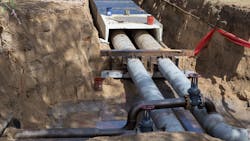Will this be the Year for Infrastructure?
The Biden Administration has been in office less than two weeks as of this writing, and while the President hit the ground running with a plethora of Executive Orders — many designed to halt actions by the previous administration and some to focus attention on priorities such as strengthening Buy America(n) requirements — these actions can not and should not take the place of the role of Congress in enacting laws and directing the work of government. Already we have seen the challenges related to passing another stimulus package.
While many of us can agree that additional stimulus aid is necessary, words and rhetoric are not sufficient to make it happen. It takes dialog, conversation, compromise, and a shared vision of what is best for our citizens, our economy, and our country. At the time of this publication, I expect something will have been worked out — a compromise to ultimately help the American people.
The same will hopefully be said for infrastructure funding. While the previous administration touted its infrastructure plan early on, nothing materialized at the end of four years. Now, we have a new administration with a new proposal and similar good intentions. The one difference may be that the COVID-19 pandemic has highlighted some of our nation’s infrastructure deficiencies such as broadband access for rural America, disparities in health care coverage and access, and the vital importance of a clean and safe water supply for hand washing and hygiene. The economic downturn and lost jobs further highlighted the importance of water as a right for all Americans as states and localities prohibited shutoffs and required utilities to turn water back on — even if customers couldn’t pay their water bills.
Passing legislation and funding to shore up our nation’s infrastructure will create jobs and help our economy grow while making us more resilient and self-sufficient. It will be a much-needed boost to help pull us out of the pandemic and get us back on the road to recovery. From a water perspective, many of the water association leaders came together last year to develop a joint policy document to address these issues and needs. Titled Sustainable Solutions For America’s Water and Wastewater Infrastructure: Urgent Funding and Policy Considerations, this document is still a thoughtful and viable roadmap for the water sector.
The call to action on both immediate needs for relief and other policy reforms reflects the consensus of these groups and their leaders regarding the top priorities that Congress should consider as it shapes the next COVID-19 stimulus or water infrastructure bill.
The water sector has agreed on a number of critical topics, including ensuring utility liquidity, providing low interest household assistance, funding for COVID-19 wastewater monitoring, increasing funding for the SRFs and WIFIA, investing in water recycling, fully funding technology grant programs, providing incentives to adopt water technologies by reducing risk, providing direct federal assistance for utility adoption of smart water technologies, expanding access to water and financial resources to more communities, and providing incentives for investment and partnerships among water and wastewater utilities. We are proud of this comprehensive approach that recognizes and seeks to fix the challenges that have persisted in the water sector for decades while at the same time launching us much further down the road to resilience. I say this is the year for infrastructure and as a water sector we are ready to help make this a reality. WW
About the Author: Vanessa M. Leiby is Executive Director of the Water and Wastewater Equipment Manufacturers Association (WWEMA). WWEMA is a non-profit trade association that has been working for water and wastewater technology and service providers since 1908. WWEMA’s members supply the most sophisticated leading-edge technologies and services, offering solutions to every water-related environmental problem and need facing today’s society. For more information about WWEMA go to www.wwema.org.
About the Author
Vanessa M. Leiby
Vanessa M. Leiby is the executive director of the Water and Wastewater Equipment Manufacturers Association (WWEMA), which has been representing water and wastewater technology and service providers since 1908. WWEMA’s members supply the most sophisticated leading-edge technologies and services, offering solutions to every water-related environmental problem and need facing today’s society. WWEMA is made up of many of the most prominent and influential companies in the industry who are working together to shape the future of water and wastewater technology in the U.S. and around the world. For more information about WWEMA, visit www.wwema.org.
